
Can you really travel for extended periods of time in a small travel trailer? For us the answer is “yes!”
Long trips, small spaces
In 2021 we traveled Route 66 from California to Chicago, followed by a visit to Indiana and a return to California. That trip was recapped in this article.
Later that year, we were back on the road for a couple more months, which included visiting the Albuquerque Balloon Fiesta.
Those trips were taken in a 16-foot travel trailer. Being on the road for 7 to 9 weeks at a time made us realize we actually could use just a few more feet of storage and living space.
In 2022, we upgraded to a new travel trailer.
We really did like our original Rockwood MiniLite, so we decided to keep ourselves in that family and we chose a Rockwood MiniLite 2205s. This travel trailer is about 19 feet inside, and has a slide-out on the driver side.
Those two additions to the size of our home away from home provided the extra storage and living space that we needed for traveling several months at a time.

Here are some tips for managing long road trips in a small RV.
Take only what you need
There are several reasons to limit what you pack into the camper. For one thing, more stuff means finding space for each thing.
Figuring out what’s necessary gets easier with each trip. In the beginning, I just kept adding and adding things I thought we might need.
After each long trip, we clean out the camper and really assess what we had riding around with us, that we never used. We have checklists for everything, including what’s kept in the camper. When we decide to remove something from the camper, we remove it from our checklist as well.
Clothing and laundry
Many RV parks have laundry rooms. If we are staying in one place for a couple of weeks, I seek out a local laundromat that might have larger, less expensive, facilities.
We plan laundry days about every two weeks. Because of this, we only need two weeks of clothing with us.
Include outfits that can mix and match. For example, for the summer I have a few pair of capri pants, and each pair matches with several of my tops. So, I can mix up my wardrobe and have a bunch of outfits without packing a bunch of clothes.
Tony has it easy. Shorts and T-shirts. And one pair of long pants for days it’s chilly, or we are going somewhere that requires our legs be covered (like RV factory tours).
We found that baskets and totes are very helpful in keeping our wardrobes neat and tidy. I also use a hanging closet organizer. I use one shelf for T-shirts, one for blouses, and one for dresses or sweaters (or both, if I have only one or two of each).
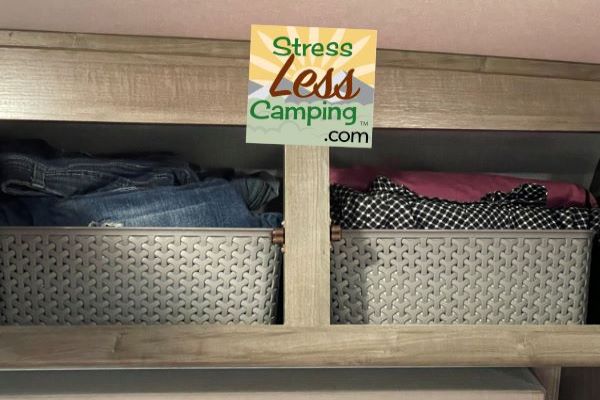
I also have had to really learn to choose my shoes wisely. I live in flip flops, and still I always seem to over-pack in the shoe department. Because, I mean, don’t I need 8 different pairs of flip flops? Plus solid shoes, for when those are needed! I now try to look at what clothing I am packing and choose just a few pairs of shoes to mix and match with those outfits.
If our trip will take us from one season to the next, we each pack an extra bag of clothes for when the season changes. That bag can store in the back of the truck or in the under-bed storage until we need to re-organize our wardrobe.
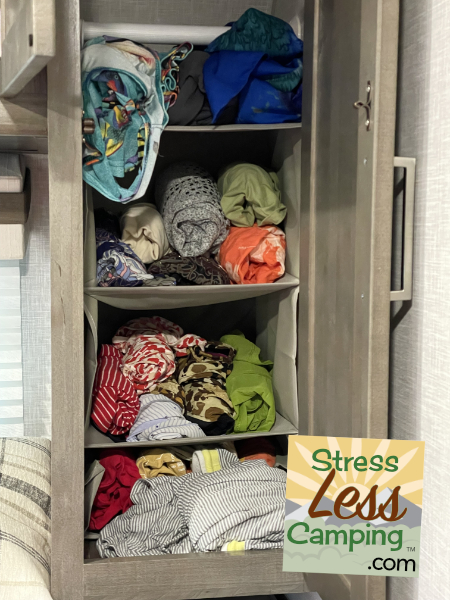 Food
Food
Another place that I have learned to be efficient is in our pantry. This became easier in 2022 when we changed our eating habits. We no longer carry baking supplies (which, honestly, we rarely used anyway), rice or pasta, or carb-loaded snacks.
One way to eat better and save on food storage space is to enjoy fresh, local fare. Find a farmer’s market and shop for only a few days at a time so your food is fresh and in season.
Just like at home, try to only buy what you are sure you will eat. A few extra cans in the pantry might come in handy, but throwing away rotting vegetables is just a waste of space and money.
The kitchen
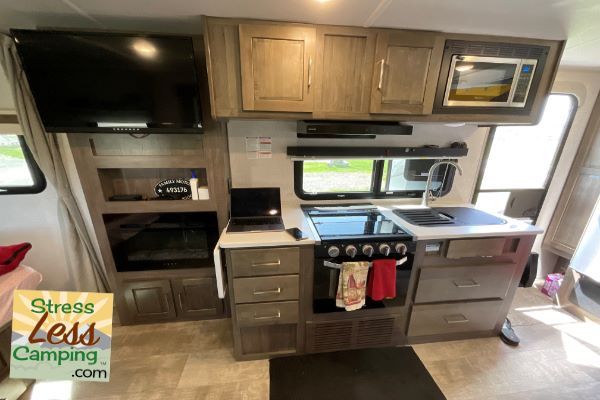
Speaking of food, you’ll of course need to prepare it. Consider the way you cook at home. If you tend to use your one favorite pan all the time, you probably will cook the same way in the RV. Don’t be tempted by all the fancy extras that you likely won’t use anyway. Trust me, I speak from experience.
Tony and I both adore gadgets. And when we have a new gadget that we find makes a task easier, naturally we want to keep it with us. This can get us into trouble in the kitchen.
Look for multi-tasking gadgets. As I said, as much as we love tools that will do that one thing really well, that tool may not be practical for the RV if another tool will do it just as well and do other tasks besides. We keep those uni-taskers in the sticks-and-bricks kitchen instead.
And, when mealtime is over and there are leftovers, we have a couple favorite storage solutions. We have collapsible, stackable silicone containers that work in the fridge, freezer, microwave, and even the oven. We also have silicone bags that snap closed and hold food (and even liquids) securely. All of these, when empty, take up very little space and are light-weight.
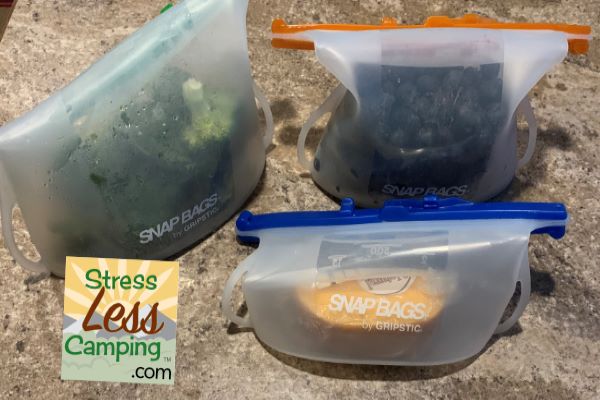
When we started our RV adventures, I insisted on keeping all 9 of our vintage dinner plates in the camper all the time. We also had a whole basket of drink ware, that we never used. Being practical about how many plates, cups, etc. we really need made it possible to store more of the items that we need on longer trips, like those extra warm clothes. We also stopped carrying the nine vintage melamine plates which couldn’t be used in the microwave, and bought four wheat straw plates instead.
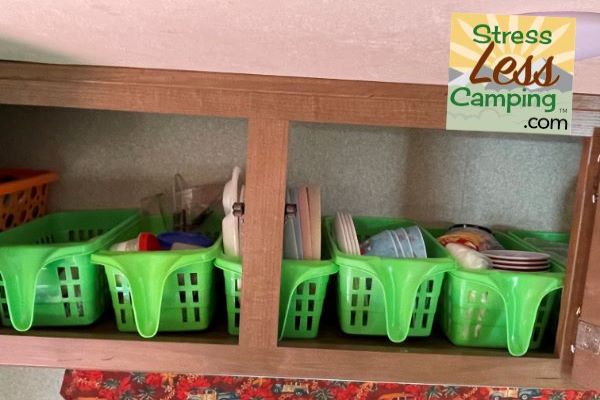
Here is an idea that I learned last year. It keeps me from feeling the need to have “service for 12” in our travel trailer. When we are camping with a group of friends, and taking turns making meals, everyone is asked to being their own service to each meal. That includes plates, utensils, napkins, and beverages. Not only does it cut down on how much we need to store, but it cuts down on dishwashing as well!
The bathroom
The bathroom is another place I have a hard time down-sizing. I tend to think “I might really need this hairspray” even though I typically only use hair spray maybe once a year. On the other hand, dry shampoo may be absolutely necessary, especially if you tend to boondock a lot and want to save water.
We have upped our towel game by replacing bulky cotton towels with towels from Almost Heaven microfiber. I have found Chris at every FMCA convention we have attended. The towels dry fast, and take up a fraction of the space. I am really picky about microfiber, so I know what you are thinking. These are a good texture.
Weight for it
Space is not the only consideration when deciding what to pack and what to leave behind. I used to have a tendency to fill up every little space – because I had a space for more things. But more things means more weight.
It’s very important not to exceed the weight capacity of your RV or your tow vehicle. We recommend packing what you think you’ll need, then take your rig to a weigh center. If you are over-weight, or even approaching the limits, re-assess. You’ll likely be buying souvenirs on your trip, so leave some room and capacity for those.
A place for everything
Again, don’t stuff every square inch with stuff. You’ll want room for things you might pick up along the way. Also, it’s hard to get organized if things are jam-packed into every nook and cranny. Save yourself a lot of frustration by minimizing what you carry. Leave room to organize and find what you are looking for. It will make your trip much more pleasant if you aren’t always digging through cabinets to find what you need.
Once you have everything in the RV that you’ll need for your trip, make sure each item has a home. Use your favorite method to get organized. For me, it’s plastic baskets. They come in all shapes and sizes, so I can get just what I need to organize each cabinet.
The storage under the bed comes in quite handy for items that we don’t need daily. When we travel from one season to another, we need jackets, warmer clothes, and warmer PJs part of the time. Those can be stashed under the bed when we don’t need them.
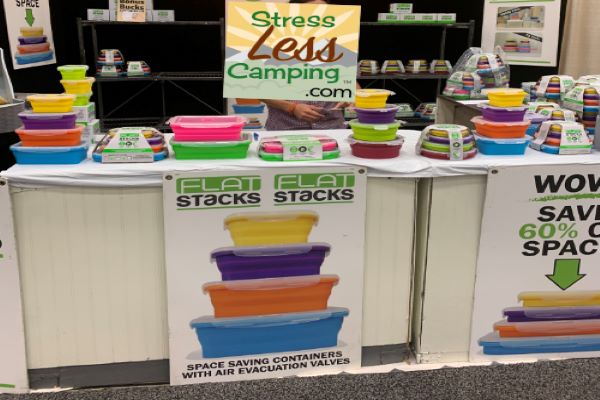
Everything in its place
When you are done with something, put it away! I know, mom tried to teach you that your whole childhood. Some of us learned better than others. Just trust men when I say, if you pile it on the bed or the counter instead of putting it away, you’ll be really frustrated when you need that counter space, or it’s bedtime and you realize you have half an hour of organizing to do before you can snuggle in.
Minor modifications
Sometimes, simple modifications can help make your travels easier. For example, we spend a lot of time sitting at our computers. The theater seating that came with our Rockwood Mini Lite was really comfortable, but not for working. We knew that for us, a work station made a lot more sense. So, we turned the slide room into an office. We first removed the theater seating with the help of our nephew. His reward was keeping the seating for his own RV. We opted instead for good quality office chairs and individual computer tables. We can each set up our most comfortable work station.
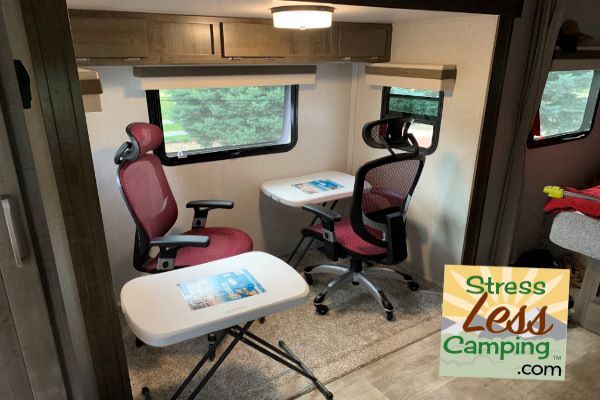
Here’s a tip for rolling office chairs: replace the casters with polyurethane roller-blade wheels. Those wheels roll over any surface silently and with ease. We also use them in our house to protect the hardwood floors. We highly recommend this swap with any chairs with casters. Here are the ones we got.
It’s funny how much we looked forward to having that theatre seating, then realized they were just way too comfortable for our working-on-the-road lifestyle. If you don’t need to sit up straight and work when in the RV, keep the theater seats. They are great for relaxing, reading, or watching TV!
Outside Storage
RVs have a great deal of variety in the outside storage that they provide. Again, remember to minimize the excess “stuff” and to keep things organized so you aren’t frustrated looking for what you need. We find plastic totes to be indispensable in our front pass-through, which is our only outside storage.
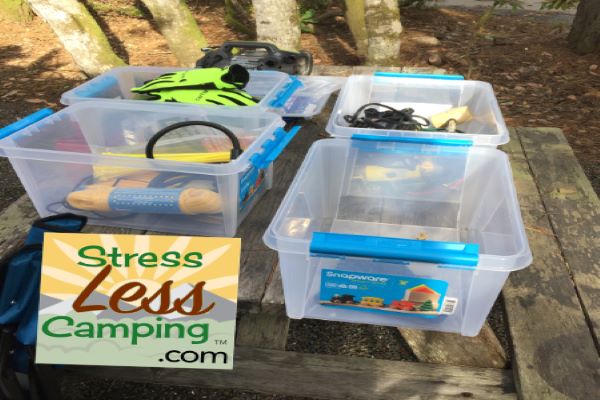
One thing we do have to be careful of, though, is adding too much weight to the tongue of the trailer by over-filling the pass-through storage. However, that area does hold bulky items such as chairs. We could not fit chairs into any outside storage area in our older trailer.
Our Rockwood MiniLite has the Mastervolt power package. You can read about the power package here. On that page, you can also see Tony enjoying those theater seats before we removed them.
ABC Upfitters has worked with their build methods to a point that the power package takes up minimal space in the pass-through. While we do lose some storage space, and have the weight of the lithium battery and inverter in the front storage, the bonus is that there aren’t batteries on the tongue of the trailer. And we can boondock “forever.”
Bumper storage
A note of caution: not all travel trailer bumpers are designed to hold weight. Many bumpers should not have have anything extra attached to them. That goes for the ladder as well. Please don’t add weight to the rear of the trailer unless you’ve checked with the manufacturer and it’s safe to do so.
We have the advantage of Rockwood’s beefed-up receiver hitch, which has a 300-pound capacity. We added a Curt Bike Rack, which you can see Tony review in this video. The rack carries our two Lectric e-bikes, which took up a great deal of the truck bed before. That clears up most of the truck bed for other things we might want to carry. More about that in a moment.
Truck bed storage
If you travel with a bumper-pull travel trailer, you have the advantage of the bed of your tow truck for storage, Again, please pay attention to the overall weight. The cargo carrying capacity of the truck includes the trailer tongue weight as well as everything in the truck. And by everything, I mean everything, including people, pets, and fuel.
We do still make use of the bed of the truck, which has a shell to keep everything secure and dry. We carry items that are too large to store in the trailer, that we need occasionally but not daily. For example, we sometimes carry a 12-volt cooler, portable washing machine, propane fire pit, grey water tote, or pellet smoker. All of these possible add-ons depend on where our travels will take us and what activities we plan during the trip.
You can do it!
It does take some trial and error, and we still find on every trip that we carried something we never ended up needing. But each time, we learn to assess our needs and make necessary adjustments. You can too!
| Tony and Peggy Barthel are RV industry veterans who travel part-time in a small travel trailer looking for fun and unique destinations as well as tips, tricks, and discounts to turn the RV adventure into StressLess Camping. You can catch them Thursday mornings on their podcast or any time at www.StressLessCamping.com. |


Leave a Reply